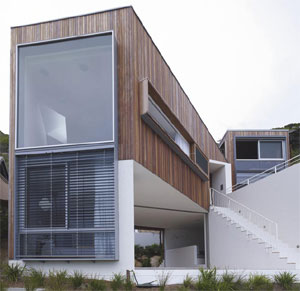Whale Beach House is located in the southeast fold of a steep, thickly vegetated hillside below a towering escarpment and looks out along the beach to Careel Head on Sydney’s northern beaches.

The positioning of the house was determined by a pragmatic mapping of adjacent building alignments, the north point and neighbours’ views and required setbacks. These invisible lines establish the oblique geometries that characterise the plan, reminiscent of Coderch’s Casa Ugalde in Spain. Challenged by overshadowing from the escarpment, the mass of the building is located as close to the street as possible, also giving space to the large boulders, rare trees and rainforest preserved at the rear.
The house is a multi-generational family weekender organised over three levels that terrace with the slope — children and grandparents on the lower level, main living areas on the mid level and parents’ “secret” timber cabin on top. The plan is stratified, each level deliberately distinct from the other with internal stairs that are virtually hidden. While the ceiling of each level is constant, the floors are stepped or topographic.
The rooms are unique in their relationship to the outside and a highly crafted fit-out was tailored specifically for the use of the occupants. Materials were chosen for specific functions: the living area’s white walls allow the focus to shift outward to the view while the timber lining in the master bedroom gives it intimacy and warmth. There are many moods to the interior, which are beautifully balanced as a whole in relation to the site.
The project explores proximity and distance, invoking the special dualities of the site — the rocky outcrops and native forest behind are given equal consideration to the front coastal panorama. Each room is considered almost autonomously, co-ordinated with the site and view. The experience of the house is cinematic as the view is partitioned so it becomes particular to each room — the horizon from the kitchen, the headland from the living room, the escarpment from the main entry, the rainforest at the back door. An array of opening types assists the orchestration — solid timber shutters that reveal the view when open, sashes that completely disappear, windows that capture the view within a sheet of fixed glass and strategic skylights for light without view. These strategies generate a spatial richness experienced as surprise.
Like its neighbours, the house is elevated above the street, providing a degree of privacy. It is strongly articulated with upper levels clad in recycled timber that will darken in time to camouflage against the backdrop of the scarp. A void through the centre of the lower masonry level creates a view through to the garden. The native landscape is metaphorically drawn through this void, connecting with neighbouring gardens across the front. Careful collaboration between the landscape architect, hydraulic engineer, ecologist and builder allowed the waterway on the northeast side of the building to be restored, resisting council’s attempts to create a stormwater easement and instead enriching the landscape setting. The house and landscape are integral. Outdoor living spaces correspond with each level of the house and are equally varied.
The project demonstrates a holistic approach to sustainability — solar orientation, natural light, ventilation, efficient internal heating, material choices, water collection, locally indigenous plantings and compact pool. The steeply sloping site was expensive to build on and the stormwater issues costly to resolve.
The refined building detailing and landscaping were labour intensive, but felt by all parties to deliver enduring benefit.
Designed by award-winning practice Neeson Murcutt Architects, the Whale Beach House took out the coveted 2009 Wilkinson Award for Residential Architecture Houses — New.
Photography by Brett Boardman
NEESON MURCUTT ARCHITECTS
Level 5, 71 York Street, Sydney NSW 2000 Tel: 02 8297 3590
Website: www.neesonmurcutt.com



